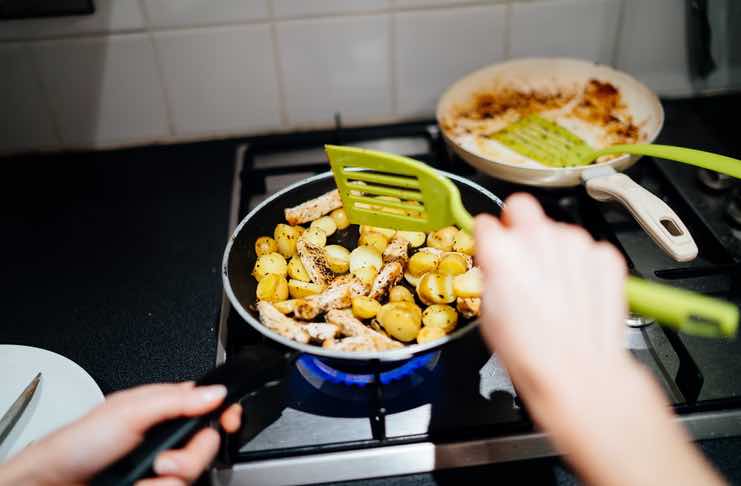Potatoes are perhaps some of the most versatile food ingredients known to humanity. Whether fried, baked, in a stew, roasted, spiced, or just lightly salted, potatoes’ appeal and potential are practically limitless.
Despite its versatility, handling potatoes may sometimes be tricky. Cooking potatoes can go wrong without pre-steps, such as blanching. In storage, cooked potatoes can go bad in terms of quality and safety.
Find out how to keep cooked potatoes safe and in the top shape below.
Do cooked potatoes go bad?
The quickest answer is yes. Potatoes go bad. Regardless of how you cook them, potatoes are considered highly perishable foods. In the food industry, potatoes are part of the TCS food group or foods that require time/temperature controls for food safety.
Cooked potatoes can spoil for as fast as 2 to 4 hours without proper controls in their storage environment. Spoilage of cooked potatoes can either show signs or not.
In most cases, spoiled cooked potatoes can emit a strong scent with the potential of signs of mold growth. No, that green, black, or white circle on top of your cooked potato is not edible. Chances are, those are molds.
Although seldom, spoiled cooked potatoes may not show signs of going bad but still cause foodborne illness. This spoilage may be the result of toxins produced by some bacteria.
What makes cooked potatoes go bad?
Potatoes are very nutritious foods and create a favorable growing medium for most microorganisms that cause foodborne illnesses. Leaving a baked or cooked potato at room temperature for more than 4 hours increases the risk of spoilage.
Under optimal conditions, bacteria on cooked potatoes can double in the amount in as fast as 20 minutes and can rapidly spoil the dish. Potatoes contain simple forms of sugar that most pathogenic microorganisms can readily use for their biological functions. Once they use these sugars, they will produce potentially harmful by-products that can endanger consumers.
Although, when stored in proper conditions, cooked potatoes can last longer without becoming spoiled.
How do you keep cooked potatoes safe?
If you plan on saving your cooked potatoes for your next meal, you need to ensure that they are stored correctly and kept away from potential contaminants. When keeping cooked potatoes wholesome, low temperature and proper food safety practices are your best friends.
Here are a few things you need to keep in mind for keeping cooked potatoes overnight:
Ensure proper cooking
Your first line of defense against spoilage of your cooked potato is to prepare it with the highest food safety standards. Sure, it’s just a potato dish, but spoilage can still put your health at risk.
When preparing your potatoes, make sure only to use dedicated tools for every group of ingredients. Using the same chopping board for your potatoes and other raw materials such as bacon for a baked potato dish will cause cross-contamination.
When preparing foods, always make sure to practice good food hygiene, such as regular and proper handwashing.
Keep in an air-tight container
Once cooked and cooled or after serving, you need to put your cooked potato in a clean, air-tight container. Your container must be previously cleaned or even sanitized to prevent cross-contamination.
Putting your cooked potatoes in a container reduces the exposure of the dish to external factors that can contaminate it.
Watch this video for some more tips on how to keep vegetables fresh for long:
Store in the refrigerator at around 40°F (5°C)
Your final step in ensuring that your cooked potatoes would not go bad overnight is to store them in a refrigerator with a temperature not higher than 40°F (5°C). At this temperature range, most pathogenic microorganisms cannot grow and multiply.
Refrigeration can slow down bacteria and other pathogens’ multiplication and delay spoilage. Under this condition, your cooked potatoes can be considered safe for up to 3 to 5 days.
Cooked potatoes are generally stored at refrigerated temperatures only and not in a freezer. Doing the latter task can potentially damage the dish’s integrity and make the product mushy – safe but mushy.
Conclusion
Food handlers in a restaurant must consistently monitor storage temperature and proper food preparation. A food safety team can use innovative solutions such as a digital Food Safety Management System to remind them to monitor these tasks. Such innovations ensure that every food safety task is performed correctly and on time.
Like cooked potatoes, any perishable food requires proper handling and storage. If you want to keep your foods longer and serve them the next day without the risk of foodborne illnesses, you need to have a solid approach to food safety.
